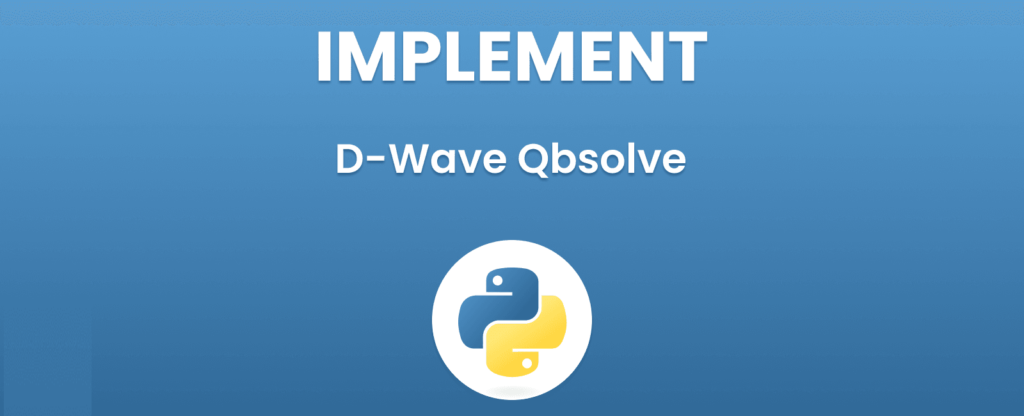How to implement dwave qbsolve in python? D-Wave qbsolv is a software tool that can be used to solve optimization problems formulated as QUBOs (quadratic unconstrained binary optimization) or Ising models using classical computing resources, such as a standard CPU, or on D-Wave’s quantum annealing processor.

What is D-Wave Qbsolve?
Qbsolv is designed to provide a simple, open-source tool for solving QUBO problems, which can be used as a heuristic solver or a benchmark against which other solvers can be compared. How to implement dwave qbsolve in python?
Qbsolv can solve small-scale QUBO problems with up to a few thousand variables by breaking the problem down into smaller subproblems and then using various classical optimization techniques to solve these subproblems. It can also be used to solve larger-scale problems by solving a series of subproblems iteratively.

When used with D-Wave’s quantum annealing processor, qbsolv can find high-quality solutions to certain types of optimization problems that are difficult for classical computing resources to solve in a reasonable amount of time.
Overall, D-Wave qbsolv is a useful tool for solving optimization problems in both classical and quantum computing environments. How to implement dwave qbsolve in python?
How to implement dwave qbsolve in python?

- To implement D-Wave’s qbsolve in Python, follow these steps:
Install the D-Wave System software package by running the following command in your terminal:
perl
pip install dwave-system2. Create a Python script in your preferred text editor.
3. Import the required libraries:
python
from dwave.system.samplers import DWaveSampler
from dwave.system.composites import EmbeddingComposite
from dwave_qbsolv import QBSolv4. Define the QUBO (quadratic unconstrained binary optimization) problem you want to solve as a dictionary with the coefficients of the variables:
css
qubo = {(0, 0): -1, (0, 1): 2, (1, 0): -2, (1, 1): 2}This QUBO represents the problem of maximizing the function f(x,y) = -x + 2xy – 2y.
5. Use qbsolv to solve the QUBO using the D-Wave sampler:
scss
sampler = EmbeddingComposite(DWaveSampler())
response = QBSolv().sample_qubo(qubo, solver=sampler)The EmbeddingComposite object is used to map the problem onto the D-Wave quantum processing unit (QPU) using a minor-embedding algorithm. The DWaveSampler object is used to access the QPU.
6. Print the results:
scss
print(response)The output will be a dictionary that contains the solutions found by qbsolv, along with their energies and other information.
For example:
yaml
{'solutions': [{0: 1, 1: 0}], 'energies': [-1.0], 'num_occurrences': [1]}This indicates that the solution x=1, y=0 maximizes the function with an energy of -1.0.
Here is the complete code:
python
from dwave.system.samplers import DWaveSampler
from dwave.system.composites import EmbeddingComposite
from dwave_qbsolv import QBSolv
# Define the QUBO problem
qubo = {(0, 0): -1, (0, 1): 2, (1, 0): -2, (1, 1): 2}
# Solve the QUBO using qbsolv and the D-Wave sampler
sampler = EmbeddingComposite(DWaveSampler())
response = QBSolv().sample_qubo(qubo, solver=sampler)
# Print the results
print(response)This code will output the results of solving the given QUBO problem using qbsolv and the D-Wave sampler. You can modify the QUBO problem as needed to solve different optimization problems. How to implement dwave qbsolve in python?
What is the Python?

Python is a high-level, interpreted programming language that was first released in 1991 by Guido van Rossum. It is a versatile language that can be used for a wide range of purposes, including web development, scientific computing, data analysis, artificial intelligence, machine learning, and more. Python is known for its simplicity, readability, and ease of use, making it a popular choice for both novice and experienced programmers.
Here are some key features of Python:
- Easy to Learn: Python has a simple and concise syntax, which makes it easy to learn and read. This means that developers can write code quickly and with less effort than many other programming languages.
- Interpreted: Python is an interpreted language, which means that the code is executed line by line by an interpreter. This makes it easy to test and debug code, and also allows for rapid development.
- Object-Oriented: Python is an object-oriented language, which means that it provides concepts such as classes, objects, and inheritance. This allows for more organized and modular code, making it easier to maintain and scale projects.
- Dynamic: Python is a dynamically typed language, which means that the type of a variable is determined at runtime. This makes it easy to write code quickly, but can also lead to errors if variable types are not handled carefully.
- Large Standard Library: Python comes with a large standard library that provides a wide range of functionality, such as string manipulation, networking, database connectivity, and more. This means that developers do not have to write as much code to accomplish common tasks.
- Cross-Platform: Python is a cross-platform language, which means that it can run on many different operating systems, including Windows, Linux, and macOS. This makes it easy to develop and deploy code across multiple platforms.
Overall, Python is a powerful and versatile programming language that can be used for a wide range of applications. Its simplicity, readability, and ease of use make it a popular choice for developers of all skill levels.
What specifically could you do? Find out in the material “How to manage your own career” .




